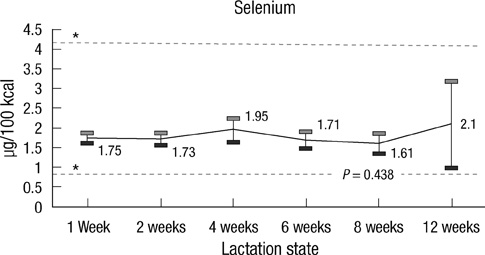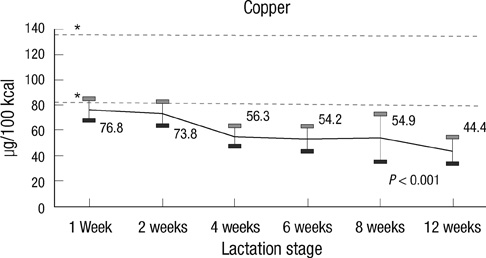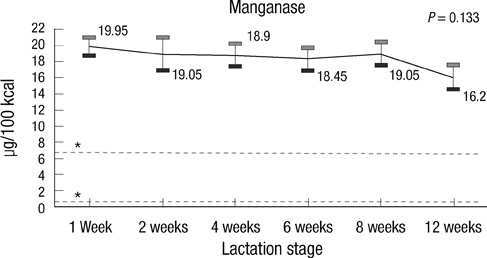J Korean Med Sci.
2012 May;27(5):532-536. 10.3346/jkms.2012.27.5.532.
Longitudinal Study on Trace Mineral Compositions (Selenium, Zinc, Copper, Manganese) in Korean Human Preterm Milk
- Affiliations
-
- 1Department of Pediatrics, Eulji University College of Medicine, Daejeon, Korea.
- 2Research Institute of Food & Nutritional Sciences, Yonsei University, Seoul, Korea.
- 3Department of Pediatrics, University of Ulsan College of Medicine, Seoul, Korea. arkim@amc.seoul.kr
- 4Department of Food & Nutrition, Yonsei University, Seoul, Korea.
- KMID: 1372796
- DOI: http://doi.org/10.3346/jkms.2012.27.5.532
Abstract
- We measured selenium, zinc, copper and manganese concentrations in the human milk of Korean mothers who gave birth to preterm infants, and compared these measurements with the recommended daily intakes. The samples of human milk were collected postpartum at week-1, -2, -4, -6, -8, and -12, from 67 mothers who gave birth to preterm infants (< 34 weeks, or birth weight < 1.8 kg). All samples were analyzed using atomic absorption spectrophotometry. The concentrations of selenium were 11.8 +/- 0.5, 11.4 +/- 0.8, 12.7 +/- 0.9, 11.4 +/- 0.8, 10.8 +/- 0.9, and 10.5 +/- 1.3 microg/L, zinc were 7.8 +/- 0.5, 9.1 +/- 0.8, 7.2 +/- 0.9, 8.0 +/- 0.8, 7.4 +/- 0.9, and 6.6 +/- 1.2 mg/L, copper were 506 +/- 23.6, 489 +/- 29.4, 384 +/- 33.6, 356 +/- 32.9, 303 +/- 35.0, and 301 +/- 48.0 microg/L and manganese were 133 +/- 4.0, 127 +/- 6.0, 125 +/- 6.0, 123 +/- 6.0, 127 +/- 6.0, and 108 +/- 9.0 microg/L at week-1, -2, -4, -6, -8, and -12, respectively. The concentrations of selenium and zinc meet the daily requirements but that of copper is low and of manganese exceeds daily requirements recommended by the American Academy of Pediatrics, Committee on Nutrition.
MeSH Terms
Figure
Reference
-
1. Narayanan I, Prakash K, Gujral VV. The value of human milk in the prevention of infection in the high-risk low-birth-weight infant. J Pediatr. 1981. 99:496–498.2. Meinzen-Derr J, Poindexter B, Wrage L, Morrow AL, Stoll B, Donovan EF. Role of human milk in extremely low birth weight infants' risk of necrotizing enterocolitis or death. J Perinatol. 2009. 29:57–62.3. O'Connor DL, Jacobs J, Hall R, Adamkin D, Auestad N, Castillo M, Connor WE, Connor SL, Fitzgerald K, Groh-Wargo S, et al. Growth and development of premature infants fed predominantly human milk, predominantly premature infant formula, or combination of human milk and premature formula. J Pediatr Gastroenterol Nutr. 2003. 37:437–446.4. Ewer AK, Durbin GM, Morgan ME, Booth IW. Gastric emptying in preterm infants. Arch Dis Child Fetal Neonatal Ed. 1994. 71:F24–F27.5. Lucas A, Morley R, Cole TJ, Lister G, Leeson-Payne C. Breast milk and subsequent intelligence quotient in children born preterm. Lancet. 1992. 339:261–264.6. Atkinson SA, Bryan MH, Anderson GH. Human milk feeding in premature infants: protein, fat and carbohydrate balances in the first 2 weeks of life. J Pediatr. 1981. 99:617–624.7. Czank C, Simmer K, Hartmann PE. Design and characterization of a human milk product for the preterm infant. Breastfeed Med. 2010. 5:59–66.8. Loui A, Raab A, Wagner M, Weigel H, Grüter-Kieslich A, Brätter P, Obladen M. Nutrition of very low birth weight infants fed human milk with or without supplemental trace elements: a randomized controlled trial. J Pediatr Gastroenterol Nutr. 2004. 39:346–353.9. Pettifor JM, Rajah R, Venter A, Moodley GP, Opperman L, Cavaleros M, Ross FP. Bone mineralization and mineral homeostasis in very low-birth-weight infants fed either human milk or fortified human milk. J Pediatr Gastroenterol Nutr. 1989. 8:217–224.10. Atkinson SA, Bryan MH, Anderson GH. Human milk: difference in nitrogen concentration in milk from mothers of term and premature infants. J Pediatr. 1978. 93:67–69.11. Rueda R, Ramírez M, García-Salmerón JL, Maldonado J, Gil A. Gestational age and origin of human milk influence total lipid and fatty acid contents. Ann Nutr Metab. 1998. 42:12–22.12. Ericson SP, McHalsky ML, Rabinow BE, Kronholm KG, Arceo CS, Weltzer JA, Ayd SW. Sampling and analysis techniques for monitoring serum for trace elements. Clin Chem. 1986. 32:1350–1356.13. Pediatric nutrition handbook. 2009. 6th ed. Elk Grove Village, IL: American Academy of Pediatrics.14. Shaw JC. Trace elements in the fetus and young infant I Zinc. Am J Dis Child. 1979. 133:1260–1268.15. Shaw JC. Trace elements in the fetus and young infant II Copper, manganese, selenium and chromium. Am J Dis Child. 1980. 134:74–81.16. Litov RE, Combs GF Jr. Selenium in pediatric nutrition. Pediatrics. 1991. 87:339–351.17. Dall'Agnola A, Beghini L. Post-discharge supplementation of vitamins and minerals for preterm neonates. Early Hum Dev. 2009. 85:S27–S29.18. Shah MD, Shah SR. Nutrient deficiencies in the premature infant. Pediatr Clin North Am. 2009. 56:1069–1083.19. Agostoni C, Buonocore G, Carnielli VP, De Curtis M, Darmaun D, Decsi T, Domellöf M, Embleton ND, Fusch C, Genzel-Boroviczeny O, et al. Enteral nutrient supply for preterm infants: commentary from the European Society of Paediatric Gastroenterology, Hepatology and Nutrition Committee on Nutrition. J Pediatr Gastroenterol Nutr. 2010. 50:85–91.20. Tamari Y, Chayama K, Tsuji H. Longitudinal study on selenium content in human milk particularly during early lactation compared to that in infant formulas and cow's milk in Japan. J Trace Elem Med Biol. 1995. 9:34–39.21. Islam MN, Chowdhury AK, Siddika M, Hossain MA, Hossain MK. Effect of zinc on growth of preterm babies. Mymensingh Med J. 2009. 18:125–130.22. Atkinson SA, Whelan D, Whyte RK, Lönnerdal B. Abnormal zinc content in human milk. Risk for development of nutritional zinc deficiency in infants. Am J Dis Child. 1989. 143:608–611.23. Yamawaki N, Yamada M, Kan-no T, Kojima T, Kaneko T, Yonekubo A. Macronutrient, mineral and trace element composition of breast milk from Japanese women. J Trace Elem Med Biol. 2005. 19:171–181.24. Lönnerdal B. Copper nutrition during infancy and childhood. Am J Clin Nutr. 1998. 67:1046S–1053S.25. Mendelson R, Anderson GH, Bryan MH. Zinc, copper and iron content of milk from mothers of pretem and full-term infants. Early Hum Dev. 1982. 6:145–151.26. Ohtake M, Tamura T. Changes in zinc and copper concentrations in breast milk and blood of Japanese women during lactation. J Nutr Sci Vitaminol (Tokyo). 1993. 39:189–200.27. Cordano A. Clinical manifestations of nutritional copper deficiency in infants and children. Am J Clin Nutr. 1998. 67:1012S–1016S.28. Casey CE, Neville MC, Hambidge KM. Studies in human lactation: secretion of zinc, copper and manganese in human milk. Am J Clin Nutr. 1989. 49:773–785.29. Friel JK, Penney S, Reid DW, Andrews WL. Zinc, copper, manganese, and iron balance of parenterally fed very low birth weight preterm infants receiving a trace element supplement. JPEN J Parenter Enteral Nutr. 1988. 12:382–386.30. Lee YW, Moon SJ, Lee MJ, Moon HN, Hong SJ. A comparative study on the composition of preterm and full term human milk in colostrums. Korean J Nutr. 1995. 28:127–136.
- Full Text Links
- Actions
-
Cited
- CITED
-
- Close
- Share
- Similar articles
-
- Micronutrient Deficiency Syndrome: Zinc, Copper and Selenium
- The protective effects of trace elements against side effects induced by ionizing radiation
- Concentrations of Major Minerals and Trace Elements in Sera of The Breast-fed and Formula-fed Infants
- Iron, Zinc and Copper Concentrations in Human Milk, Serum and Hair of Neonates
- Trace Elements Deficiency and the Diagnostic Usefulness of Hair Mineral Analysis in Children with Chronic Gastrointestinal Disease





